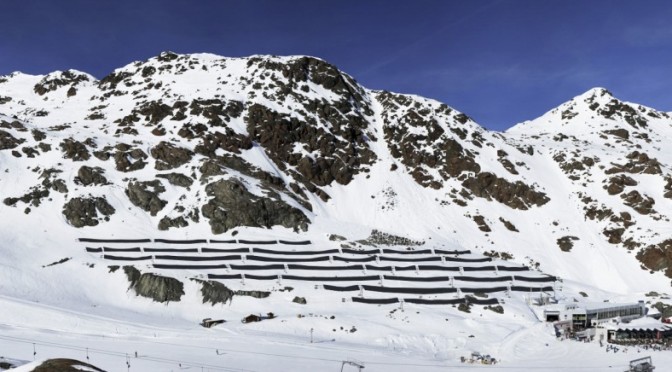It’s true that in the latter decades of the last century some resort development in some countries left a lot to be desired. But it’s equally true that ski resorts were among the first in the world to take on board the issue of climate change (it is after all something of a no brainer for an industry that is set to be one of the first victims of it…)
Over the past decade in particular, the ethos of ski resort management has swung around completely so that environment management and minimising CO2 emissions is at the forefront of resort planning whenever a new infrastructure investment is announced.
In a study of the world’s top 250 ski areas by research organisation SaveOurSnow, which keeps track of ski industry environmental initiatives, for example, just under a quarter of areas were found to be 100% green-energy powered. In quite a few cases resorts were actually generating the power they used themselves with hydro, wind or solar power facilities.
Amongst these are some of the world’s biggest resorts. Whistler Blackcomb opened its Fitzsimmons hydro-electric plant directly below its famous Peak-2-Peak gondola a few years ago, which generates more energy than the resort consumes.
In Aspen an innovative project will capture methane gas being released from abandoned silver mines (the region was world famous for its silver mines a century before it became world famous for its skiing) and will convert this to energy, again aiming to match the ski area’s power consumption – so saving both climate changing gas emissions AND creating green energy in the process.
Closer to home the ski lift manufacturer SunKid installed a ski lift last winter with solar panels built in to its structure that again generates more power than the lift needs to run, and another company, Doppelmayr, did a similar thing with a drag lift, suspending solar panels on two wires above it. The wires allow the panels to be turned vertical when it snows to allow the snow to slide off.
A similar technique will be used in summer 2015 when Europe’s highest solar farm is installed at Pitztal, Austria’s highest ski slopes above 3,400m, which also has one of Europe’s longest seasons, from September to May. Their €2.5m project will see the panels collect 40% more energy than panels located at sea level and again the resort says power generated will exceed its energy needs.
These are just the headline projects. Visit any ski resort these days and you’re likely to see solar panels and wind turbines are the norm, alongside many ‘unseen’ green initiatives, one of the biggest being ever more energy efficient snowmaking systems that allow more snow to be made for a fraction of the energy requirements of the old machines.
The 3 Valleys are among areas trialling hybrid electric piste bashers, French resorts including la Clusaz and Serre Chevalier have introduced electric car rentals this winter and electric or hybrid-gas powered ski buses are also an increasingly visible feature.
At Killington in Vermont, among many other initiatives, the resort has managed to find a green solution for the ironic issue of money spent on refrigeration for those thousands of drinks skiers and boarders knock back to cool down after warming up on the slopes. Ironically, considering ski areas are generally in sub zero environments, a lot of energy is consumed keeping refrigerator temperatures constantly cool but not freezing. However a local inventor has patented a way to do just that using green energy and natural refrigeration.
Consider too, that while ski resorts are constantly targeted as an example of mankind’s excess and (often unfairly for the reasons stated above) as bad guardians of the environment, it is actually summer resorts that tend to waste more energy from old fashioned air conditioning systems to keep hotels cool rather than ski resorts do keeping their highly efficient buildings warm – in the case of Austrian areas in particular, often with community biomass systems.
The list goes on and on if only commentators took the trouble to look, because environmental awareness is really embedded in the thinking and ethos of most resorts.
And it’s not just the resorts, although environmental awareness is perhaps not yet quite so embedded in ski clothing and equipment manufacturers as it is with the destinations, there are some shining examples of companies doing their best to produce equipment to a green agenda, often smaller businesses run by dedicated teams. New UK snowboard manufacturing company Striding Edge, based in and inspired by the Lake District area of Northern England is one such example.
Striding Edge Snowboards have released a range of eco-friendly snowboards using sustainable bamboo in the construction of the boards. They also produce climate neutral t-shirts and are using green energy company Ecotricity as an energy provider.
“Striding Edge is committed to putting the environment at the heart of every decision we make. Our goal is for Striding Edge to be 100% carbon neutral within the next two years and to become an important part of the UK snowboard scene.”
Company founder Graham Koppenhol.
About the author: Patrick Thorne has been a full time, year round, professional ski writer for 30 years. Nicknamed “The Snow Hunter” he has identified 100 countries where it is possible to ski and located more than 6,000 ski areas in 80 countries, visiting more than 260 ski resorts personally. Along with editing the InTheSnow website, Patrick has contributed regularly to The Independent since the late 1990s, in recent years working as snow travel columnist for The Independent on Sunday.
